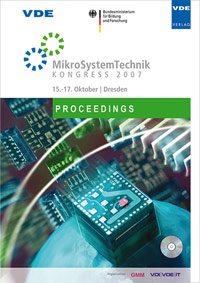Micro Needle Based Electrode Arrays for Surface Electromyography
Konferenz: MikroSystemTechnik - KONGRESS 2007
15.10.2007 - 17.10.2007 in Dresden, Germany
Tagungsband: MikroSystemTechnik
Seiten: 4Sprache: EnglischTyp: PDF
Persönliche VDE-Mitglieder erhalten auf diesen Artikel 10% Rabatt
Autoren:
Ruther, P.; Trautmann, A.; Paul, O. (Microsystem Materials Laboratory, Department of Microsystems Engineering (IMTEK), University of Freiburg, Germany)
Lapatki, B. (Department of Orthodontics, University of Freiburg, Germany)
Inhalt:
This paper describes a novel approach for surface electromyography (sEMG) measurements using micro needle based electrodes. In contrast to conventional grid arrays with planar silver electrodes on a flexible printed circuit board (PCB), chips comprising an array of metallized silicon micro needles attached to the PCB are applied. These micro needles enable the penetration of the epidermis for a direct electrical access to the dermis e.g. to identify action potentials of individual motor units. The micro needle arrays are fabricated using the suspended etch mask technology in conjunction with anisotropic and isotropic dry etching processes in an inductively coupled plasma etcher. Through-wafer vias (TWVs) are realized using an anisotropic etch process from the wafer rear with an aluminum layer on the wafer front serving as an etch stop layer. The chips are metallized using sputter deposition (100 nm TiW, 1 µm Pt) and electroplating (1 µm gold). The electrical contact between wafer front and rear is established via the TWVs. Arrays of 6×10 needle chips each with a size of 2×2 mm2 and a pitch of 4 mm are attached to the flexible PCB using conductive silver bonding. The fabricated electrode grids were used for sEMG recordings from the biceps brachii muscle. The grids were attached to the unprepared skin by application of a slight pressure. Bipolar signals with a maximum amplitude of about 150 muV could be recorded. Signals of consecutive electrodes in muscle fiber direction show the propagation of the sEMG signals. Comparable recordings can be made using arrays with flat silver-disk electrodes. In the latter case however, the preparation of the skin (necessary for reducing the electrode-to-skin impedance) and attachment of the electrodes is much more time-consuming and complicated.


